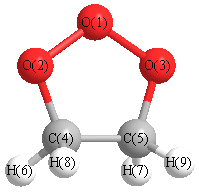Vibrational Frequencies calculated at CCSD(T)=FULL/cc-pVTZ
| Mode Number |
Symmetry |
Frequency
(cm-1) |
Scaled Frequency
(cm-1) |
IR Intensities
(km mol-1) |
Raman Act
(Å4/u) |
Dep P |
Dep U |
|---|
| 1 |
A' |
3152 |
3020 |
|
|
|
|
| 2 |
A' |
3089 |
2959 |
|
|
|
|
| 3 |
A' |
1536 |
1472 |
|
|
|
|
| 4 |
A' |
1359 |
1302 |
|
|
|
|
| 5 |
A' |
1261 |
1208 |
|
|
|
|
| 6 |
A' |
1035 |
992 |
|
|
|
|
| 7 |
A' |
960 |
920 |
|
|
|
|
| 8 |
A' |
897 |
859 |
|
|
|
|
| 9 |
A' |
864 |
828 |
|
|
|
|
| 10 |
A' |
707 |
677 |
|
|
|
|
| 11 |
A' |
417 |
399 |
|
|
|
|
| 12 |
A" |
3134 |
3003 |
|
|
|
|
| 13 |
A" |
3076 |
2947 |
|
|
|
|
| 14 |
A" |
1520 |
1456 |
|
|
|
|
| 15 |
A" |
1366 |
1309 |
|
|
|
|
| 16 |
A" |
1244 |
1192 |
|
|
|
|
| 17 |
A" |
1166 |
1117 |
|
|
|
|
| 18 |
A" |
1048 |
1004 |
|
|
|
|
| 19 |
A" |
754 |
723 |
|
|
|
|
| 20 |
A" |
712 |
682 |
|
|
|
|
| 21 |
A" |
122 |
117 |
|
|
|
|
Unscaled Zero Point Vibrational Energy (zpe) 14709.3 cm
-1
Scaled (by 0.958) Zero Point Vibrational Energy (zpe) 14091.5 cm
-1
See section
III.C.1 List or set vibrational scaling factors
to change the scale factors used here.
See section
III.C.2
Calculate a vibrational scaling factor for a given set of molecules
to determine the least squares best scaling factor.
